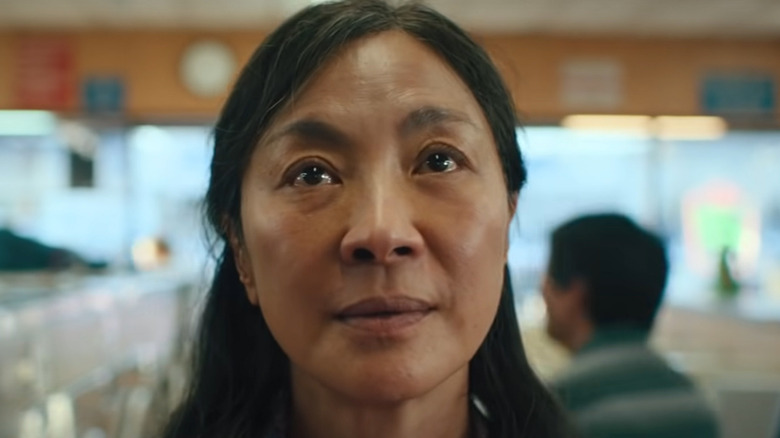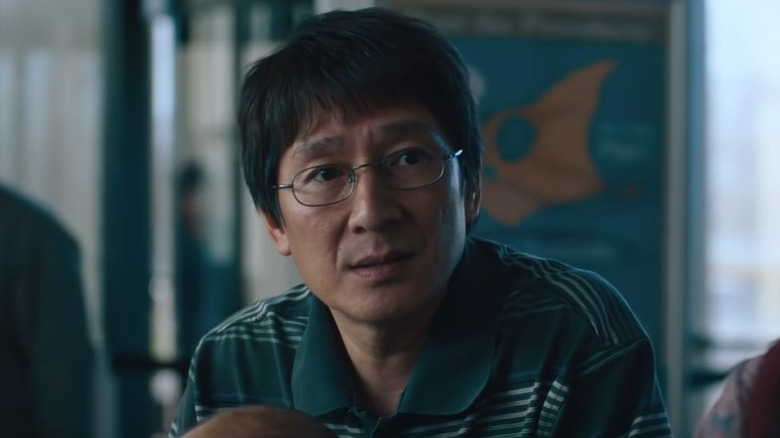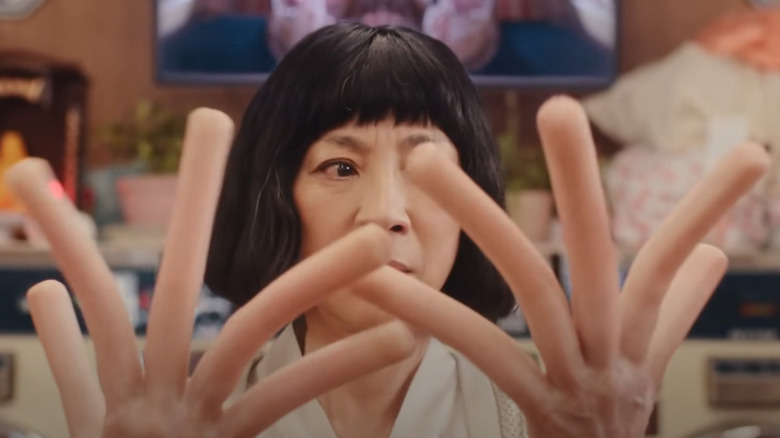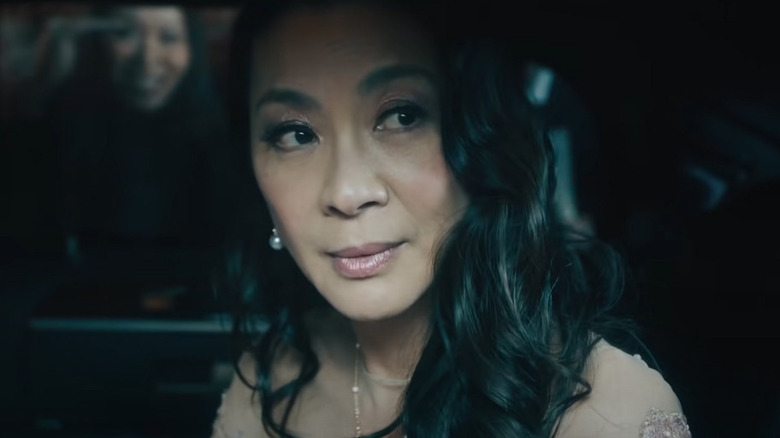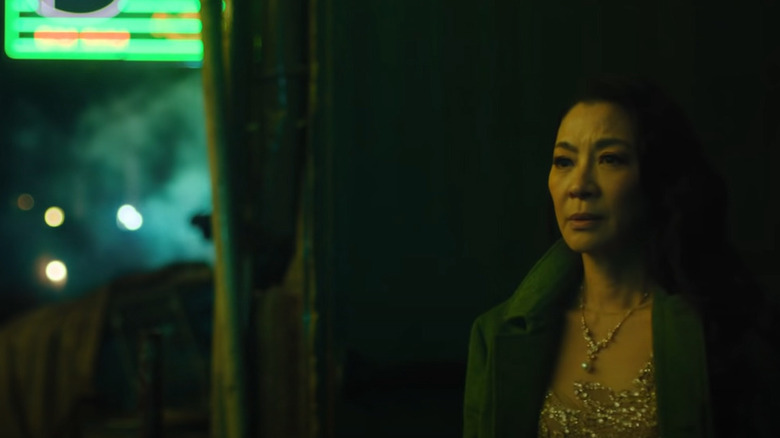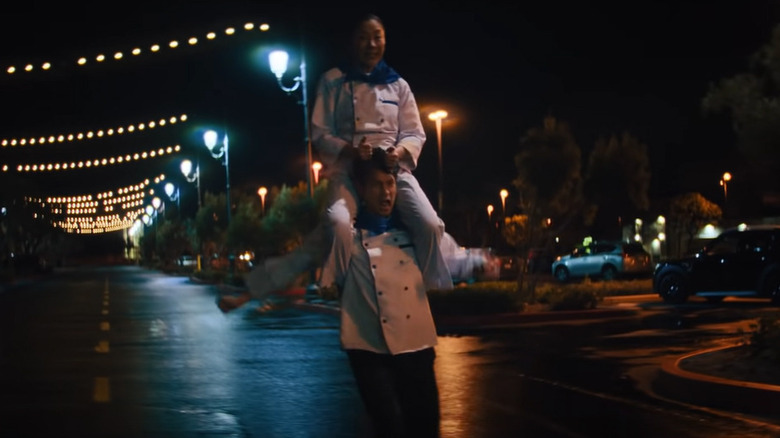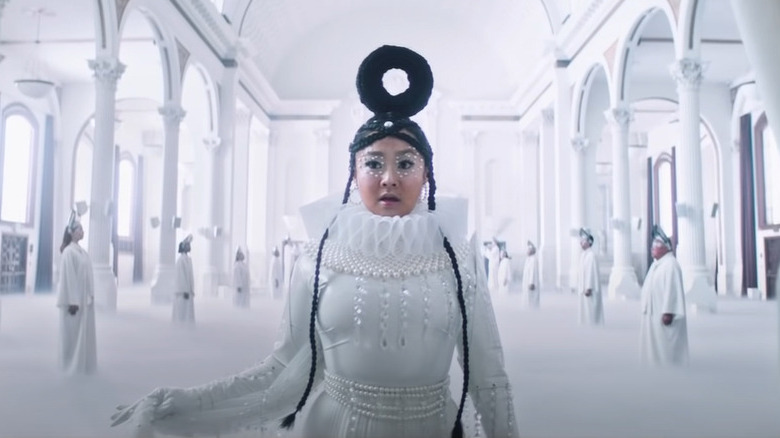The Most Confusing Moments Of Everything Everywhere All At Once
"Everything Everywhere All at Once" is an emotionally- charged mind-freak of a genre exercise. It is at once an absurd comedy, a thrilling action picture, and one of the most spiritually affecting films to come out in recent memory. But before viewers can get to its cathartic core, they must contend with hot dog fingers, R-rated power-ups, and some of the most intricate and ridiculous storytelling ever packed into a movie.
Michelle Yeoh stars as Evelyn Wang, matriarch of a family that runs a laundromat, who is struggling with the omnipresent stress of her life. On the eve of a tax audit that could potentially bring her livelihood crumbling to the ground, she is visited by an alternate universe variant of her husband Waymond (Ke Huy Quan), who reveals a mythical quest. Evelyn is the lynchpin of a plan to save the multiverse from the villainous entity Jobu Tupaki. To become powerful enough to stop Jobu from snuffing out every living thing in existence, Evelyn must access the skills and strengths of the multiverse's other Evelyns.
By the film's end, no stone is truly left unturned, but "Everything Everywhere All at Once" is still a lot. If you left the theater scratching your head, we totally understand — and we're here to help. These are the most confusing moments of "Everything Everywhere All at Once," explained.
Warning: Spoilers ahead for "Everything Everywhere All at Once."
What are you doing with that lip balm, Waymond?
After the basics of the film's multiversal plot line are explained, the alternate Waymond has to extricate Evelyn from a dangerous situation using impressive and unexpected martial arts prowess. Before doing so, he retrieves a tube of lip balm from his fanny pack and chews it, unlocking preternatural abilities. It turns out that people who hop between universes can access skillsets possessed by alternate versions of themselves by finding the universe where a version of them knows how to do the relevant task.
This is reminiscent of the way freed minds can re-enter the titular system in "The Matrix" and download weapons and abilities at the drop of a hat. But the work taken to acquire this knowledge in "Everything Everywhere All at Once" is messier and more complicated. In order to make a connection with whatever universe the necessary skills are from, the user must perform something random enough to channel said universe's probability wavelength.
At first, these "random events" are simple enough: Eating lip balm, giving yourself a specific number of paper cuts, and loudly professing love for someone who is trying to kill you all qualify. But as the film progresses, the skills and the work necessary get stranger and stranger. Perhaps the strangest act of all arrives when Evelyn must fight two of Jobu's disciples: They each battle to ram giant awards up their sphincters in order to steal martial arts skills from alternate universe versions of themselves.
A world full of hot dog fingers
The process of hopping through universes is delicate and takes a lot of time and training to hone. Evelyn is very new to all of this, and the circumstances do not afford her the luxury of lengthy instruction. As such, she fails early on when she tries to access a universe that can make her a better fighter. Instead of gaining skills, she accidentally connects to a world where everyone has long, bendy, cylindrical fingers that are exactly as goofy as they sound.
As the film explains, a particular aberration causes each universe to branch off on its own. Every time Evelyn is shown one of these branches, she can see exactly where in her life she moved away from the path and created it. But this particular universe is hand-waved away as being inexplicable — it's just a world where, somehow, humans evolved to have hands with hot dog fingers.
This is initially played for laughs. But in subsequent scenes, we return to this alternate world, where Evelyn is in a relationship with an alternate version of Deirdre (Jamie Lee Curtis), her IRS auditor. This big, broad joke turns out to contain real catharsis and a sweet metaphor about how even in a world where we have hot dogs for fingers, we get better at using our feet.
Hollywood ending
One of the more straightforward universes Evelyn encounters is the one she draws the bulk of her martial arts skill from. It's a version of her life where she never left China with her future husband Waymond, and wound up meeting a teacher who relentlessly trained her to be a skilled fighter. She became so talented, in fact, that she moved to Hollywood and became a huge movie star renowned for her work in action films — not unlike Yeoh herself.
This is a cute little tidbit which plays a little like the Julia Roberts gag in "Ocean's Twelve." But a galaxy brain moment comes later in the film, which takes the meta-commentary to a whole new level. At a point in the film's runtime that could reasonably serve as an endpoint, Evelyn "dies," and the credits begin to actually roll. They're the real credits, crediting the real filmmakers, which sells this moment as the saddest ending to a movie imaginable ... before pulling out to reveal that in the Hollywood Evelyn timeline, the movie premiere she has been at this whole time is for the movie we've been watching, which follows the main Evelyn's journey.
This fake-out works incredibly well, because "Everything Everywhere All at Once" is longer than similar films. Its faux ending is thus conceivable — and all the more so because the plot has already seeded the Hollywood angle so well. A movie this dense can lay out many call-back opportunities that don't feel cheap upon payoff — the viewer is simply too busy to dwell on every single detail. It's a fascinating trick that's really well done.
Evelyn and Waymond are in the mood for love
In the Hollywood Evelyn universe, this version of our heroine runs into the Waymond she hasn't seen since they broke up in her youth. She's astonished to see him looking well, having assumed he grew destitute from financial failure in America without her there to steer and motivate him. But this Waymond seems healthy, successful, and strangely at peace.
Many of the alternate worlds Evelyn has seen seem better than her own: She's happier in them because she didn't get married, didn't have a family, and didn't end up taking care of the father who made her this way. But this universe plunges further into the film's "What if?" premise to show the folly inherent in its perspective. It's also one of the most important strands of the film's tightly-woven third act, because it's key to reminding Evelyn why she fell for Waymond in the first place. Even in a world where she abandoned him, he's still willing to give them another shot, because he loves her that much.
But some viewers may be put off by the seemingly strange way these sequences are shot. This movie maintains a kaleidoscopic visual language that encompasses a lot of tones, to account for multiple universes. This sequence, however, has more of its own style than almost any other — it is uniquely melodramatic. As some cinephiles will notice, it specifically calls to mind the work of Wong Kar-wai, particularly the films "In The Mood For Love" and its quasi-sequel, "2046."
This allows the film to pay homage to a key creative influence, while also letting Yeoh and Quan flex their chops as semi-stand-ins for Maggie Cheung and Tony Leung. It's not quite as nutty as the rest of the film, but still a fascinating aberration.
Rac-a-coon-y
It's hard to recall a film with as persistent and odd a running joke as the subplot involving Chad (Harry Shum Jr.) and his intimate relationship with a raccoon. Early on, when Evelyn is trying to explain the fantastical events going on to Waymond and their daughter Joy, she struggles to outline everything the viewer has had to learn very quickly. But the major sticking point in her explanation is her attempt to express that there is another Waymond, and that that Waymond keeps taking control of her Waymond's body. In trying to make sense of it, she references the movie "Ratatouille," remarking upon the similarities between Waymond's body being controlled and the way Remy steers chef Linguini in that Pixar classic. Unfortunately, Evelyn doesn't remember the film correctly, and keeps insisting Remy is a raccoon and not a rat.
The "raccacoony" jokes continue, reappearing when Evelyn is fighting Chad, one of Jobu's henchmen, and sees him in a parallel world where they are competing chefs at a hibachi restaurant. Chad appears to be the more focused and skilled chef, but later, Evelyn discovers that he's being controlled by a raccoon he keeps under his hat — exactly the way Remy operates in "Ratatouille."
What could have been a simple and cute payoff to the earlier raccoon jokes turns out to be another important lynchpin in the film's ornate and emotional climax. Evelyn forms connections with each of the henchmen she battles by finding kinship with them in alternative universes. She helps make restitution for outing Chad's raccoon friend by helping him catch up to the police car taking him away. True to form for a film this absurd, she does so by having him jump on her shoulders and control her body so she can run fast enough to try to get him back.
Who is Jobu Tupaki?
The biggest reveal of "Everything Everywhere All at Once" comes relatively early on, but the full scope of its implications take a while to unpack. At first, all we know about the existential threat that is Jobu Tupaki is that they were once someone who hopped between universes like others from the Alpha world, and that keeping too many alternate realities together in one mind caused them to crack. Soon after, we learn that Jobu is Joy, Evelyn's daughter. In the Alpha world, Evelyn, the first person to discover the multiverse's existence, pushed her daughter harder and harder. Eventually, she lost herself and became a profoundly powerful agent of chaos and destruction.
Our Evelyn's initial forays into 'verse-hopping prove difficult, because all she sees are better versions of herself and her life. But what Jobu/Joy experiences is more harrowing. She can see that in every world, no matter what dynamic forms between her and her mother, there is still suffering and confusion. She exists in infinite worlds, and all of them stink. Initially, it seems like Jobu/Joy is obsessed with finding and killing every Evelyn as revenge, but really, she wants to find one who will understand her and see existence for what it is, so she doesn't have to struggle alone.
Jobu's godlike abilities showcase some of the film's most fascinating and visually arresting ideas, but the real magic is in the emotional underpinning of her arc. The over-the-top villain origin of Joy being pushed too hard by her scientist mother is suitable for the genre, but every infraction from every Evelyn onto every Joy is portrayed as equally cataclysmic. Our Evelyn's key betrayal — hiding Joy's sexuality from Gong Gong, Evelyn's father — proves to be just as traumatic and harmful as another Evelyn experimenting on her daughter until she became a kind of anti-deity. This is the key to the film's exploration of existence and generational trauma.
